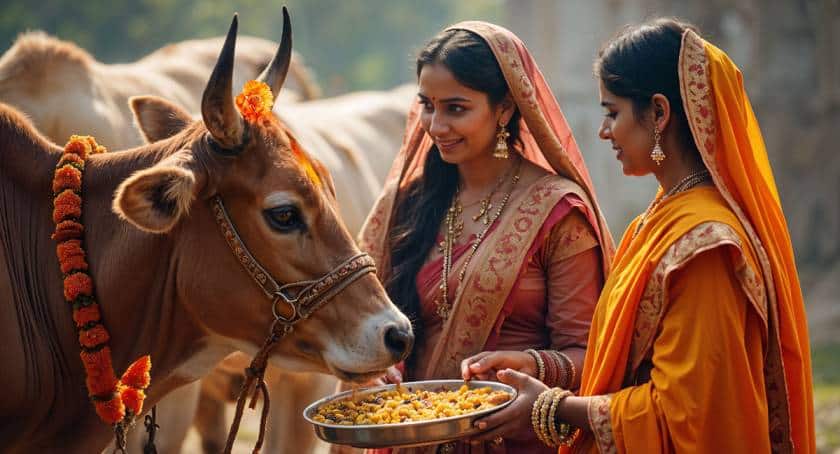Gahma Purnima: A Celebration of Farmers and Cattle in Odisha
Odisha, a land of rich traditions and vibrant cultural heritage, celebrates numerous festivals yearly. Gahma Purnima is a unique festival that honors farmers and cattle, recognizing their invaluable contribution to agriculture. This festival, observed on the full moon day of the Shravan month, is deeply rooted in agrarian traditions and reflects the strong bond between humans, nature, and livestock.
Gahma Purnima is not just a festival; it is a tribute to the hard work and dedication of the farming community. In Odisha, where agriculture is the primary occupation for a significant portion of the population, cattle play an indispensable role in plowing fields, transportation, and providing essential dairy products. Farmers use the celebration to show appreciation for their farm animals and ensure their profitability and well-being. Additionally, Gahma Purnima coincides with Raksha Bandhan and Gamha Diyan, further enriching its cultural and social significance.
The Cultural and Agricultural Significance of Gahma Purnima
The festival of Gahma Purnima embodies gratitude, reverence, and devotion. In agrarian societies like Odisha, people have long considered cattle sacred and have relied on them to sustain rural livelihoods. Farmers depend on cattle to plow their fields and produce dairy products, a significant source of nutrition and income. Gahma Purnima recognizes this and serves as a reminder of how humans and animals may work together for mutual benefit.
Apart from its agricultural importance, the festival also marks a time of familial and social bonding. Since it coincides with Raksha Bandhan, it fosters love and unity among siblings. Additionally, Gamha Diyan, a practice involving folk games and cultural performances, further enhances the celebratory spirit of the occasion.
Mythological Roots and Divine Blessings
Gahma Purnima has a strong mythological association with Lord Baladeva, the elder brother of Lord Krishna. People revere Lord Baladeva as the god of agriculture and farming, seeking his blessings for a bountiful harvest. According to local beliefs, people dedicate the festival to his worship, offering prayers in temples and homes to seek his divine grace.
Additionally, the celebration highlights the significance of bulls and cows in Hindu mythology. Many ancient scriptures regard cows as symbols of wealth and prosperity. During Gahma Purnima, the people of Odisha demonstrate their dedication to sustainable agriculture and traditional farming methods by celebrating cattle.
Traditional Rituals and Customs
Gahma Purnima is celebrated with various rituals, customs, and festivities that reflect Odisha’s deep-rooted cultural ethos.
- Worship of Cattle
On the morning of Gahma Purnima, farmers wake up early to bathe their cattle and adorn them with turmeric, sandalwood paste, and vermilion. The animals are decorated with garlands and offered exceptional food, including rice, jaggery, and fruits. This ritual signifies the farmers’ appreciation for their cattle’s hard work and labor, ensuring their health and well-being.
- Special Puja for Lord Baladeva
Temples dedicated to Lord Baladeva witness grand celebrations, with devotees offering prayers, flowers, and traditional sweets. In many villages, community feasts and kirtans (devotional singing) are organized, adding a spiritual dimension to the festival. People believe that worshipping Lord Baladeva brings farmers prosperity and good fortune.
- Raksha Bandhan Connection
Since Gahma Purnima coincides with Raksha Bandhan, it is also a time for siblings to strengthen their bonds. While brothers give gifts as a sign of affection and gratitude, sisters tie rakhis on their brothers’ wrists in prayer for their safety and well-being. This dual celebration enhances the festive atmosphere and brings families together.
- Gamha Diyan and Folk Performances
Another fascinating aspect of Gahma Purnima is Gamha Diyan, a tradition where young children and villagers participate in folk games, music, and dance performances. These cultural activities promote community bonding and ensure that they pass down traditional art forms through generations. The lively atmosphere of Gamha Diyan adds to the joyous spirit of the festival.
Festive Delicacies of Gahma Purnima
No festival in Odisha is complete without a delectable array of traditional dishes. During Gahma Purnima, families prepare and share a variety of festive delicacies that add flavor to the celebrations. Some of the most popular dishes include:
- Pitha (Rice Cakes): Rice, coconut, and jaggery make Chakuli Pitha, Manda Pitha, and Arisa Pitha.
- Kheer: A sweet rice pudding prepared with milk, sugar, and dry fruits, symbolizing prosperity and joy.
- Dalma: A wholesome lentil and vegetable stew enhanced with flavorful spices and ghee.
- Chenna Poda: A renowned Odia confection crafted from caramelized cottage cheese, presenting a rich and distinctive flavor.
These culinary delights are enjoyed within families and shared with neighbors and guests, reinforcing the values of generosity and togetherness.
The Cultural Impact of Gahma Purnima
Gahma Purnima is more than just a religious festival; it celebrates agrarian life that fosters a sense of community and gratitude. It highlights the importance of cattle in traditional farming practices and strengthens the human-animal relationship. Through its various rituals and festivities, the festival instills values of hard work, patience, and respect for nature.
The festival also serves as a platform for preserving Odisha’s rich cultural heritage. The traditional music, folk performances, and festival cuisine of Gahma Purnima serve to keep the younger generations anchored in their culture.
Final Thoughts
Gahma Purnima is a festival that beautifully encapsulates the spirit of gratitude, devotion, and togetherness. It honors the tireless efforts of farmers and the indispensable role of cattle in agriculture. By celebrating this festival, Odisha continues to cherish and preserve its cultural and agrarian legacy. Whether through traditional rituals, community feasts, or heartfelt prayers, Gahma Purnima remains a significant and meaningful festival for the people of Odisha, reinforcing the harmony between man, nature, and livestock. In an ever-changing world, such traditions serve as a bridge between the past and the future, ensuring that the values of respect, hard work, and gratitude continue to thrive.


